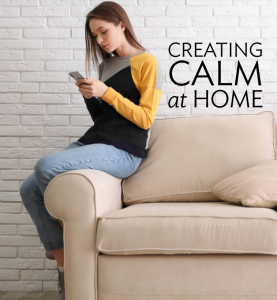Creating Calm at Home
By Michelle Anne, PCC, DAIS
*This is an article from the Fall 2021 issue of Contentment Magazine.
Creating a stable, secure, and loving home environment is foundational to creating the positive outlook we need to go through this next phase of transitions. But how do we do that when so many of us are triggered and stressed?
Most of us recognize the feelings evoked by this fictional, but all too typical, scenario:
Last night my spouse, Ben, was upset with me for watching a television program with my son, Joe. This didn’t make much sense to me, but I listened and said, “I love you,” and drifted off to sleep. This morning, I awoke feeling peaceful, but when I saw Ben’s back to me, I soon remembered he was upset with me. I touched his back and softly whispered, “Good morning, I love you.” Returning from the bathroom, I sensed something was still upsetting him, so I sat next to him and spoke from my heart. Again, I expressed that I loved him, but I noticed he was holding his breath. I asked him if he wanted to say anything and he said, “No! Sally, if I said something it would just create a bigger issue.” I understood and decided to go about my workday.
Throughout the day, I checked in with him. He was still visibly upset. By dinner time I asked if he would like to eat together. He said, “No.” Later that evening, I wandered into my empty college daughter’s room, aware of and confused by the palpable silence in the house. As I’m lying there, my son came in wondering why we are fighting. He is also affected by our silence throughout the day—we all are. The house is uncomfortable for everyone.
One drop of water has many ripples. Realizing how stress affects our behavior, affects our children, our spouse, and our work relationships is critical to consciously creating the environment of stability, security, and love that we need to traverse the uncertainty of the upcoming transitions of our lives: kids returning to school, our re-entry into the workplace, etc.
Stressors of any level unconsciously trigger us into a reaction. The bad thing is we wind up in an increasingly uncomfortable situation, the cause and effect creating more reactions. Many times, we are uncertain of why we are stressed or how the situation arose, but we are reactive, nonetheless.
Let’s discuss and dissect the story above. Something triggered Ben in the above situation. He may or may not have realized he was stressed. When we are uncomfortable, our tendency is to react. Blaming or lashing out at another person is a common stress reaction. However, we need to remember that everyone responds to stress differently in different situations. Sally responds by withdrawing into her daughter’s room. Her son responds by worrying about why they are fighting.
The good news: re-wiring your brain’s relationship with stress is very possible and not hard to do. Neuroplasticity is the brain’s ability to rewire or change, making new neural connections throughout life. What I am saying is you can get rid of the triggers!
In neuroscience we look carefully at the brain’s response to stress triggers trying to understand what is happening in the brain and what triggers different people. We find a never-ending cycle…there is a trigger (person, place, or thing) that stresses us; there is a reaction; and typically, this action causes another reaction, and so on. The technical term for what we have now is “a mess.” We have all been there, and too often than not, we do not know how to change the habits or get rid of the trigger that started it.
Yoga, widely recognized as a practice to bring calm and peace into your life, offers another lens for looking inside this dilemma. Many of us have had the experience of being in a yoga class when the instructor asks us to hold a posture, to go longer, to adjust our hip, hold, keep holding… The longer we hold the posture, the more likely our brain becomes increasingly uncomfortable. We begin to think, “How long are we going to be here? Am I doing this right? Look at that person–how are they doing that? They are better than me.” The brain is anything but calm and relaxed. This is a simple study of awareness, noticing that the brain is anxious when it is uncomfortable. Ok… now what?
To re-wire our habits and create the calm, stable loving home we want and need in transition, it is imperative to understand how our brain reacts to stressful situations. Stress usually derails us. Whether the trigger is within us, our spouse, our kids, or our boss, our response either defuses or escalates the situation.
Blending my study of eastern philosophy and western neuroscience, I offer you ways to reduce the triggers or end the never-ending cause and effect cycle of stress:
When our brain perceives a threat, or when we perceive the demands on it exceed its capacity, we experience a stress reaction. This usually includes an uncomfortable feeling inside our body. Something feels off, not aligned. It may feel like weird energy or a feeling of anxiousness. We all experience this a little bit differently. We need to recognize these feelings. Literally slow down and feel the energy, even if it feels uncomfortable.
Allow the discomfort to be there; accept that we feel that way. When we allow the energy to just be there, it fades like the fog in the sun. It might help to visualize the energy in the body moving, energy that wants to come up and out. When we fight the feeling by ignoring it or reacting, the uncomfortable energy and feelings increase. (Remember, what we focus on magnifies and amplifies.)
To create an environment of stability and calm in ourselves and our homes, we need to learn to control our reaction and relax when feeling uncomfortable or stressed. Go back to the yoga class visualization. When the instructor is having us hold the posture and we notice that tendency to feel increasingly anxious, we can deliberately begin to relax our shoulders, relax our abdomen, and wipe all expression from our face. The brain does what we tell it!! And this tells the brain to stimulate the parasympathetic nervous system – or the relaxation response. By repeatedly telling the brain to relax when in an anxious state, we are hard-wiring new neural networks. Over time this will change our relationship with stressors of all kinds.
Thus, by becoming aware of the uncomfortable feeling, slowing down, acknowledging it, allowing it, regulating our response, and relaxing our body, we can switch into a different, more relaxed, and calm state of mind. This takes effort and time to cultivate.
Each time you feel stressed apply these steps (SWAT®)
1. Slow down.
2. Withdraw your focus inward to how the body feels.
3. Accept, allow the uncomfortable energy. (Don’t label it or judge yourself.)
4. Trigger relaxation in your shoulders, abdomen, face. Stay there!
Re-wiring your stress response has lifelong benefits. Think of it this way… you’ll have plenty of opportunity to try this in life. You can either do what you have been doing (how’s that working?) or try something different.
In my 10 years of study with a guru, I have learned how quickly I have been able to deliberately re-wire my stress response and get rid of my triggers altogether. This process has revealed an inner stability in myself, a security that I can overcome challenges in peace, bring calm to myself, my family, and a room that is anxious. (This is a great help in meetings and when I give keynotes!) Learning these techniques has eliminated my 50+ allergies; helped me create an honest, calm, prosperous home; and deepened my relationships with my family, changing my life both on the inside and out.
Now more than ever, we need the foundation of a calm, secure and loving home to support our ability to stay positive through the changes ahead. Everyone wants to come home to a warm, predictable, stable environment. The first step is building an inner stability that will radiate throughout your life!
ABOUT THE AUTHOR
 Michelle Anne’s education includes study in Neuroscience & Leadership from Harvard University. She holds a Liberal Arts degree from Miami University. She also studied Communication Design at Parsons School of Design. Michelle is a Diplomat at The American Institute of Stress and is an ICF Certified Master Executive Neuro Coach. Michelle has acted as a Virtual First Responder for the Harvard Medical School, coaching front liners to manage the impacts of COVID-19. In addition, Michelle has a 19 year background in Stress Management including training in MBSR (Mindful-based Stress Reduction), 10 year study in Eastern philosophy, and is honored to have been bestowed the esteemed title of Acharya (one who teaches by how they live) by a revered swami in India. For more information see https://themasterscourse.com/. Michelle can be reached at [email protected].
Michelle Anne’s education includes study in Neuroscience & Leadership from Harvard University. She holds a Liberal Arts degree from Miami University. She also studied Communication Design at Parsons School of Design. Michelle is a Diplomat at The American Institute of Stress and is an ICF Certified Master Executive Neuro Coach. Michelle has acted as a Virtual First Responder for the Harvard Medical School, coaching front liners to manage the impacts of COVID-19. In addition, Michelle has a 19 year background in Stress Management including training in MBSR (Mindful-based Stress Reduction), 10 year study in Eastern philosophy, and is honored to have been bestowed the esteemed title of Acharya (one who teaches by how they live) by a revered swami in India. For more information see https://themasterscourse.com/. Michelle can be reached at [email protected].
Contentment Magazine
The dictionary defines “content” as being in a state of peaceful happiness. The AIS magazine is called Contentment because we want all of our guests and members to find contentment in their lives by learning about stress management and finding what works best for each them. Stress is unavoidable, and comes in many shapes and sizes that makes being in a state of peaceful happiness seem like a very lofty goal. But happiness is easy to find once you are able to find ways to manage your stress and keep a healthy perspective when going though difficult times in life. You will always have stress, but stress does not always have you!

Leave A Comment
You must be logged in to post a comment.